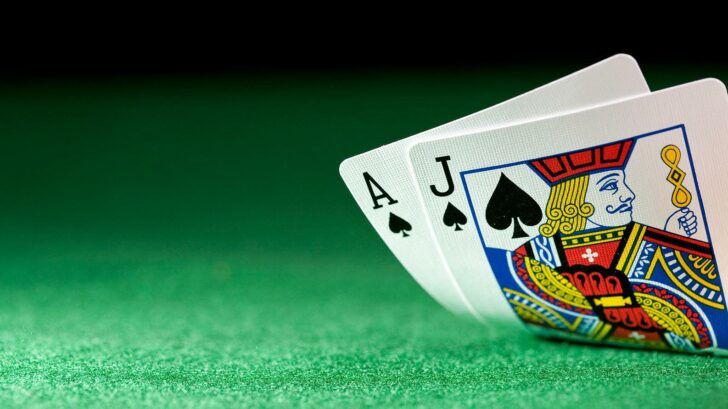Why Single Deck Blackjack is Fool’s Gold That Smart Strategy Players Should Avoid Like the Plague

 Single-Deck Trap
Single-Deck TrapThe amount of decks in the shoe has a surprising impact on the house edge. While single-deck games are supposed to be player friendly, casinos have tweaked the rules to take more money out of your pockets.
Blackjack looks simple on the surface. You hit, stand, split and double down in the hope of getting close to 21 without going over. But as one gets deeper and deeper into the game, all kinds of minor details and unexpected twists come out of the woodwork. Blackjack is a like a tree. You can’t see most of the nuance until you get up close.
This piece will take a look at one aspect of blackjack which seems small but has a big impact on the house edge: the number of decks. The more decks in the shoe, the lower the player’s chance of leaving the casino with more money than they came with. We’ll investigate how this has evolved over time, paying special attention to the current resurgence of single-deck games.
Why does deck number matter?
Back in the glory days of casino gambling most casinos dealt blackjack games out of a single deck. Once that deck ran out, the croupier would simply reshuffle and start dealing again. That was how blackjack was played, and these games had a standard house edge of roughly .5 percent.
But then something happened during the 1960s and 70s that made casino executives very uncomfortable. Some players had become very good at blackjack. So good, in fact, that casinos were losing a lot of money. It turned out that these big winners were using card counting systems, allowing them to predict which cards would be dealt in upcoming hands.
Casinos turned to different tactics in order to stop this, including training staff to sniff out counters. Most importantly, they started dealing from two, four, six and even eight decks instead of one. This made counting much more difficult, as players now had to convert a running count into a true count, something that requires a lot of skill and concentration. It’s also proven that games with more decks have slightly higher house edges, even for non-advantage players.
Deck number in practice
Looking at a survey of blackjack tables in Las Vegas casinos highlights the difference that the number of decks makes. Three casinos, the Excalibur, Luxor and Golden Nugget, all have the same set of rules on both two and six-deck tables: dealer hits on a soft 17 and the player can double down after splitting but surrendering and re-splitting aces are prohibited.
What difference do we find? At all three casinos the two-deck game has a house edge of .45 percent, better than average. But when four additional decks are added to shoe, the edge jumps up to .64 percent, pretty significant in the blackjack world.
For non-advanced blackjack strategy players, this mostly boils down to the fact that doubling down is less effective when more decks are being used. Removing one card tells the player very little when there are multiple decks left in the shoe, whereas with only one deck it says a lot. And the vast majority of games these days use six decks, meaning things aren’t as player-friendly as they once were.
So, single deck is good right?
While six-deck is the current standard, single-deck blackjack is making a comeback in Vegas casinos like the Venetian and Palazzo. In theory, the edge in a single-deck game should be almost negligible, only about .1-.2 percent in the house’s favor. When playing single-deck, the player will win more hands than in other blackjack rules variations.
While casinos are allowing players to win more hands this way, they’ve found another way to tip the edge in their favor, and in a very significant way. Most of these games pay only 6-5 on a natural blackjack, not the standard 3-2 found in other games.
Normally when you get lucky enough to land a blackjack you should receive $15 for every $10 you bet. But in 6-5, you only receive $12. On average a player will land a blackjack in one out of every 20 hands. A player will play about 60 hands per hour, adding up to a loss of $9 per hour. Over an entire night or weekend, this becomes a lot of money
So significant in fact that an analysis by BusinessInsider found that this rule change increases the house edge by roughly 1.36 percent, a very significant number. In blackjack the player is going to lose the majority of hands regardless, so they need to capitalize the payout on hands which they do win. The 6-5 rule throws a wrench into that, costing players a lot of money over time.
Plenty of other good options out there
Don’t be a sucker. Steer clear of these games at all cost. You need not worry, as there are tons of Vegas casinos with player-friendly blackjack tables. The Bellagio has a six deck, $15 minimum table with a house edge of only .28 percent (we think this is the best game in the entire city).
For those willing to bet $100 per hand, Harrah’s has a six deck with a .35 percent edge. In general player-friendly tables involve higher minimum bets, but if you shop around you’re certain to find something that works for you. Just don’t fall into the single-deck trap.




